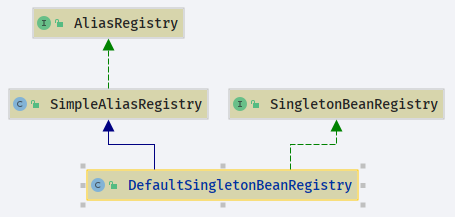DefaultSingletonBeanRegistry
- Author: HuiFer
- 源码阅读仓库: SourceHot-Spring
- 源码路径:
org.springframework.beans.factory.support.DefaultSingletonBeanRegistry - 官方提供的测试类:
org.springframework.beans.factory.support.DefaultSingletonBeanRegistryTests
类图

注册方法解析
- 从名字可以看出这是一个单例对象的注册类
org.springframework.beans.factory.support.DefaultSingletonBeanRegistry.registerSingleton测试用例出发
@Testpublic void testSingletons() {DefaultSingletonBeanRegistry beanRegistry = new DefaultSingletonBeanRegistry();TestBean tb = new TestBean();beanRegistry.registerSingleton("tb", tb);assertSame(tb, beanRegistry.getSingleton("tb"));TestBean tb2 = (TestBean) beanRegistry.getSingleton("tb2", new ObjectFactory<Object>() {@Overridepublic Object getObject() throws BeansException {return new TestBean();}});assertSame(tb2, beanRegistry.getSingleton("tb2"));assertSame(tb, beanRegistry.getSingleton("tb"));assertSame(tb2, beanRegistry.getSingleton("tb2"));assertEquals(2, beanRegistry.getSingletonCount());String[] names = beanRegistry.getSingletonNames();assertEquals(2, names.length);assertEquals("tb", names[0]);assertEquals("tb2", names[1]);beanRegistry.destroySingletons();assertEquals(0, beanRegistry.getSingletonCount());assertEquals(0, beanRegistry.getSingletonNames().length);}
第一个关注的方法
org.springframework.beans.factory.support.DefaultSingletonBeanRegistry#registerSingleton注册单例对象
/*** 注册一个单例对象** @param beanName the name of the bean* @param singletonObject the existing singleton object* @throws IllegalStateException*/@Overridepublic void registerSingleton(String beanName, Object singletonObject) throws IllegalStateException {Assert.notNull(beanName, "Bean name must not be null");Assert.notNull(singletonObject, "Singleton object must not be null");synchronized (this.singletonObjects) {// 通过beanName获取单例对象Object oldObject = this.singletonObjects.get(beanName);// 不为空异常if (oldObject != null) {throw new IllegalStateException("Could not register object [" + singletonObject +"] under bean name '" + beanName + "': there is already object [" + oldObject + "] bound");}// 添加方法addSingleton(beanName, singletonObject);}}
/*** Add the given singleton object to the singleton cache of this factory.* <p>To be called for eager registration of singletons.* <p>* 添加单例对象的操作方法** @param beanName the name of the bean* @param singletonObject the singleton object*/protected void addSingleton(String beanName, Object singletonObject) {synchronized (this.singletonObjects) {this.singletonObjects.put(beanName, singletonObject);this.singletonFactories.remove(beanName);this.earlySingletonObjects.remove(beanName);this.registeredSingletons.add(beanName);}}
- 这些变量是什么
/*** 单例对象的缓存: beanName -> Object*/private final Map<String, Object> singletonObjects = new ConcurrentHashMap<>(256);/*** 单例工厂的缓存: beanName -> ObjectFactory。*/private final Map<String, ObjectFactory<?>> singletonFactories = new HashMap<>(16);/*** 延迟加载的单例对象缓存: beanName -> Object*/private final Map<String, Object> earlySingletonObjects = new HashMap<>(16);/*** 已经注册过的单例对象名称(beanName)*/private final Set<String> registeredSingletons = new LinkedHashSet<>(256);/*** 当前正在创建的单例对象名称(beanName)*/private final Set<String> singletonsCurrentlyInCreation =Collections.newSetFromMap(new ConcurrentHashMap<>(16));private final Set<String> inCreationCheckExclusions =Collections.newSetFromMap(new ConcurrentHashMap<>(16));/*** 摧毁单例对象*/private final Map<String, Object> disposableBeans = new LinkedHashMap<>();private final Map<String, Set<String>> containedBeanMap = new ConcurrentHashMap<>(16);/*** bean 和beanName的关系*/private final Map<String, Set<String>> dependentBeanMap = new ConcurrentHashMap<>(64);/*** bean 依赖关系 beanName -> 依赖关系*/private final Map<String, Set<String>> dependenciesForBeanMap = new ConcurrentHashMap<>(64);/*** 异常列表*/@Nullableprivate Set<Exception> suppressedExceptions;/*** 标记是否在 destroySingletons 上*/private boolean singletonsCurrentlyInDestruction = false;
- 注册方法至此结束
获取方法解析
org.springframework.beans.factory.support.DefaultSingletonBeanRegistry.getSingleton(java.lang.String)
@Override@Nullablepublic Object getSingleton(String beanName) {return getSingleton(beanName, true);}
@Nullableprotected Object getSingleton(String beanName, boolean allowEarlyReference) {// 从列表中获取单例对象Object singletonObject = this.singletonObjects.get(beanName);// 判断当前beanName是否存在if (singletonObject == null && isSingletonCurrentlyInCreation(beanName)) {synchronized (this.singletonObjects) {// 从延迟加载中获取singletonObject = this.earlySingletonObjects.get(beanName);if (singletonObject == null && allowEarlyReference) {// 从singletonFactories获取ObjectFactoryObjectFactory<?> singletonFactory = this.singletonFactories.get(beanName);if (singletonFactory != null) {// 获取对象singletonObject = singletonFactory.getObject();// 加入缓存this.earlySingletonObjects.put(beanName, singletonObject);this.singletonFactories.remove(beanName);}}}}return singletonObject;}
- 获取单例对象的本质就是从 map 中获取 ObjectFactory 进而执行 getObject()
ObjectFactory<?> singletonFactory = this.singletonFactories.get(beanName); - 测试方法
TestBean tb2 = (TestBean) beanRegistry.getSingleton("tb2", new ObjectFactory<Object>() {@Overridepublic Object getObject() throws BeansException {return new TestBean();}});
- 获取单例对象的方式
public Object getSingleton(String beanName, ObjectFactory<?> singletonFactory) {Assert.notNull(beanName, "Bean name must not be null");synchronized (this.singletonObjects) {// 从单例对象中获取一个对象Object singletonObject = this.singletonObjects.get(beanName);if (singletonObject == null) {if (this.singletonsCurrentlyInDestruction) {throw new BeanCreationNotAllowedException(beanName,"Singleton bean creation not allowed while singletons of this factory are in destruction " +"(Do not request a bean from a BeanFactory in a destroy method implementation!)");}if (logger.isDebugEnabled()) {logger.debug("Creating shared instance of singleton bean '" + beanName + "'");}beforeSingletonCreation(beanName);boolean newSingleton = false;boolean recordSuppressedExceptions = (this.suppressedExceptions == null);if (recordSuppressedExceptions) {this.suppressedExceptions = new LinkedHashSet<>();}try {// 调用自定义实现,或者接口实现singletonObject = singletonFactory.getObject();newSingleton = true;}catch (IllegalStateException ex) {// Has the singleton object implicitly appeared in the meantime ->// if yes, proceed with it since the exception indicates that state.singletonObject = this.singletonObjects.get(beanName);if (singletonObject == null) {throw ex;}}catch (BeanCreationException ex) {if (recordSuppressedExceptions) {for (Exception suppressedException : this.suppressedExceptions) {ex.addRelatedCause(suppressedException);}}throw ex;}finally {if (recordSuppressedExceptions) {this.suppressedExceptions = null;}afterSingletonCreation(beanName);}if (newSingleton) {addSingleton(beanName, singletonObject);}}return singletonObject;}}
不难发现最后都是通过singletonObject = singletonFactory.getObject();进行获取
这个地方的方法实际上就是测试类中的
new ObjectFactory<Object>() {@Overridepublic Object getObject() throws BeansException {return new TestBean();}}
通过getObject就可以获取当前对象

